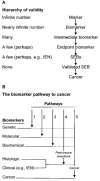Regulatory approval of cancer risk-reducing (chemopreventive) drugs: moving what we have learned into the clinic
- PMID: 21372031
- PMCID: PMC3059243
- DOI: 10.1158/1940-6207.CAPR-09-0014
Regulatory approval of cancer risk-reducing (chemopreventive) drugs: moving what we have learned into the clinic
Abstract
This article endeavors to clarify the current requirements and status of regulatory approval for chemoprevention (risk reduction) drugs and discusses possible improvements to the regulatory pathway for chemoprevention. Covering a wide range of topics in as much depth as space allows, this report is written in a style to facilitate the understanding of nonscientists and to serve as a framework for informing the directions of experts engaged more deeply with this issue. Key topics we cover here are as follows: a history of definitive cancer chemoprevention trials and their influence on the evolution of regulatory assessments; a brief review of the long-standing success of pharmacologic risk reduction of cardiovascular diseases and its relevance to approval for cancer risk reduction drugs; the use and limitations of biomarkers for developing and the approval of cancer risk reduction drugs; the identification of individuals at a high(er) risk for cancer and who are appropriate candidates for risk reduction drugs; business models that should incentivize pharmaceutical industry investment in cancer risk reduction; a summary of scientific and institutional barriers to development of cancer risk reduction drugs; and a summary of major recommendations that should help facilitate the pathway to regulatory approval for pharmacologic cancer risk reduction drugs.
Conflict of interest statement
Figures



Comment in
-
Cancer chemoprevention--the cardiovascular model.Cancer Prev Res (Phila). 2011 Mar;4(3):307-10. doi: 10.1158/1940-6207.CAPR-11-0049. Cancer Prev Res (Phila). 2011. PMID: 21372030 No abstract available.
Similar articles
-
Executive Summary of the National Cancer Institute Workshop: Highlights and recommendations.Urology. 2001 Apr;57(4 Suppl 1):4-27. doi: 10.1016/s0090-4295(00)00931-6. Urology. 2001. PMID: 11295590
-
Cancer chemoprevention and cancer preventive vaccines--a call to action: leaders of diverse stakeholder groups present strategies for overcoming multiple barriers to meet an urgent need.Cancer Res. 2006 Dec 15;66(24):11540-9. doi: 10.1158/0008-5472.CAN-06-4122. Epub 2006 Dec 7. Cancer Res. 2006. PMID: 17158189
-
Cancer risk factors for selecting cohorts for large-scale chemoprevention trials.J Cell Biochem Suppl. 1996;25:29-36. J Cell Biochem Suppl. 1996. PMID: 9027595 Review.
-
Food extracts for chemoprevention: quo vadis?Cancer Prev Res (Phila). 2009 Jul;2(7):608-10. doi: 10.1158/1940-6207.CAPR-09-0102. Cancer Prev Res (Phila). 2009. PMID: 19584073 No abstract available.
-
Cancer chemoprevention: successes and failures.Clin Chem. 2013 Jan;59(1):94-101. doi: 10.1373/clinchem.2012.185389. Epub 2012 Nov 13. Clin Chem. 2013. PMID: 23150056 Review.
Cited by
-
Back to the future: mechanism-based, mutation-specific combination chemoprevention with a synthetic lethality approach.Cancer Prev Res (Phila). 2011 May;4(5):628-32. doi: 10.1158/1940-6207.CAPR-11-0162. Cancer Prev Res (Phila). 2011. PMID: 21543341 Free PMC article.
-
Molecular cancer prevention: Current status and future directions.CA Cancer J Clin. 2015 Sep-Oct;65(5):345-83. doi: 10.3322/caac.21287. Epub 2015 Aug 18. CA Cancer J Clin. 2015. PMID: 26284997 Free PMC article. Review.
-
Bioassay-Guided Isolation of Antioxidant and Cytoprotective Constituents from a Maqui Berry (Aristotelia chilensis) Dietary Supplement Ingredient As Markers for Qualitative and Quantitative Analysis.J Agric Food Chem. 2017 Oct 4;65(39):8634-8642. doi: 10.1021/acs.jafc.7b03261. Epub 2017 Sep 26. J Agric Food Chem. 2017. PMID: 28910091 Free PMC article.
-
Chemopreventive Potential of Caryophyllane Sesquiterpenes: An Overview of Preliminary Evidence.Cancers (Basel). 2020 Oct 18;12(10):3034. doi: 10.3390/cancers12103034. Cancers (Basel). 2020. PMID: 33081075 Free PMC article. Review.
-
Lynch syndrome cancer vaccines: A roadmap for the development of precision immunoprevention strategies.Front Oncol. 2023 Mar 22;13:1147590. doi: 10.3389/fonc.2023.1147590. eCollection 2023. Front Oncol. 2023. PMID: 37035178 Free PMC article. Review.
References
-
- Herberman RB, Pearce HL, Lippman SM, Pyenson BS, Alberts DS. Cancer chemoprevention and cancer preventive vaccines--a call to action: leaders of diverse stakeholder groups present strategies for overcoming multiple barriers to meet an urgent need. Cancer Res. 2006;66:11540–9. - PubMed
-
- Woolf SH. The power of prevention and what it requires. JAMA. 2008;299:2437–9. - PubMed
-
- Hong WK, Endicott J, Itri LM, et al. 13-cis-retinoic acid in the treatment of oral leukoplakia. N Engl J Med. 1986;315:1501–5. - PubMed
-
- Meyskens FL, Jr, Surwit E, Moon TE, et al. Enhancement of regression of cervical intraepithelial neoplasia II (moderate dysplasia) with topically applied all-trans-retinoic acid: a randomized trial. J Natl Cancer Inst. 1994;86:539–43. - PubMed
-
- Hong WK, Lippman SM, Itri LM, et al. Prevention of second primary tumors with isotretinoin in squamous-cell carcinoma of the head and neck. N Engl J Med. 1990;323:795–801. - PubMed

